Dive In To The Paradise Of Nature At Ghangaria Village
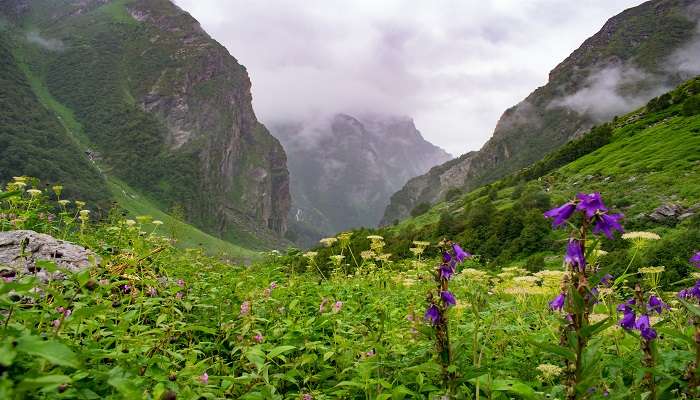
Ghangaria Village, located in the northern Himalayas in the Indian state of Uttarakhand, is the last human-inhabited village in the Ghangaria Village.At an altitude of 3049 meters, the village is a popular base camp for trekkers heading to higher locations such as the Valley of Flowers, a national park known for its collection of alpine flowers, and Hemkund Sahib, a popular site of pilgrimage in Sikhism. Ghangaria boasts stunning views of its natural surroundings, ranging from snow-capped mountains to pristine waterfalls and much more.
About The Ghangaria Village
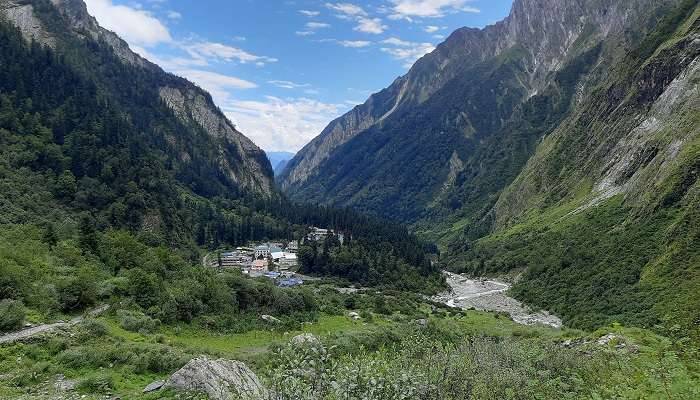
Also known as Gobind Dham due to its proximity to the Gurudwara grounds, Ghangaria is located at a confluence of river Pushpawati. This forms the Lakshman Ganga at Ghargaria, which later meets Alaknanda at Govindghat. Its untouched environment can be attributed to its population of approximately one hundred people, who lead a mostly rural lifestyle. Ghangaria is becoming increasingly popular within the trekking community due to its ideal location for many trekking base camps.
Ghagaria is a base camp for popular trekking routes to places such as the Valley of Flowers and Hemkund Sahib. Furthermore, the trekking routes to the rivers of Zanskar offer breathtaking views of the valley, making them memorable treks. It is a popular pilgrimage site with temples such as Ghanteshwar Mahadev Temple, Bhairavnath Temple, Gauri Shankar Temple, and Nageshwar Mahadev Temple.
Must Read: Places To Visit In Uttarakhand
Places To See Near Ghangaria Village
Enjoy the breathtaking attractions near Ghangaria Village to make your journey memorable. Let’s look at some of the places further.
1. Valley Of Flowers
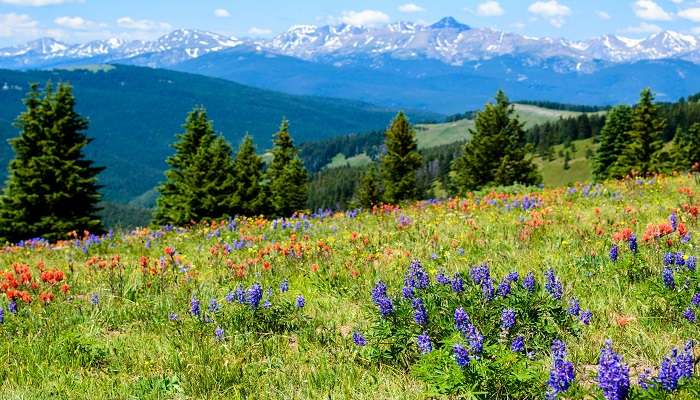
The Valley of Flowers is a UNESCO World Heritage Site in Uttarakhand, India, that is truly one of a kind. It is a short trek away from Ghangaria and is full of flora of different types and colours, resembling a palette of vibrant paints. Located at the junction where the Zanskar and Western and Eastern Himalayas meet, the valley is home to thousands of flower species, including ferns, blue poppies, primula, etc.
Visitors must visit the Valley of Flowers between August and September to witness its stunning best. It offers visitors views like never before, making it the perfect place for photos and rejuvenation.
2. Hemkund Sahib
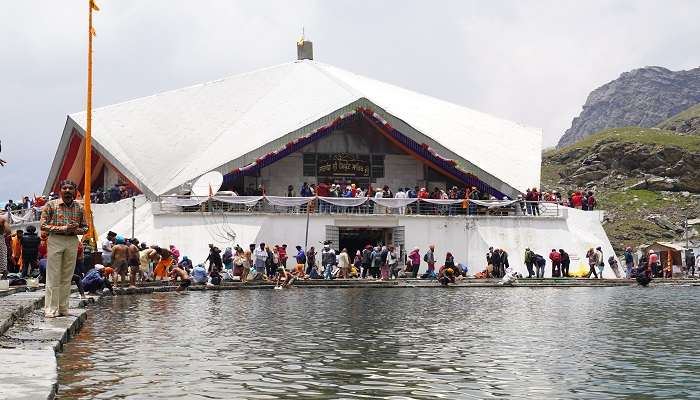
The Hemkund Sahib is a Sikh pilgrimage site located in the Garwhal mountains. Popular belief is that Guru Gobind Singh Ji, the tenth Sikh Guru, meditated for ten years in the now Gurudwara spot. Devotees from all over the country and the world visit this site due to the sheer power of their beliefs.
The gurudwara and the lake are holy sites for Hindus and Sikhs, who often trek from Ghangaria to an altitude of about 1000 m. Although the trek is challenging due to the altitude change and the nature of the terrain, the trekkers’ devotion is the ultimate motivation for them to undertake this magical journey.
Suggested Read: Trek To Valley Of Flowers
3. Hemkund Lake
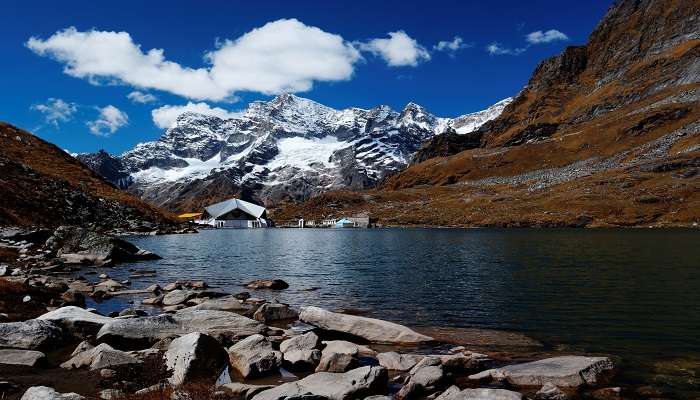
In addition to the Hemkund Sahib Gurudwara, the Hemkund Lake is one of the most holy places for Hindu and Sikh devotees in the region. Nestled among stunning mountains and epic landscapes, the lake is a site of Hindu belief. Devotees worldwide visit the lake, and many choose to dip in the water.
It is advised that visitors take the dip only during the summer or on a day with particularly pleasant temperatures since the water tends to be freezing and could be dangerous. Nevertheless, devotees are not deterred and choose to visit in all seasons.
Important Information And Tips
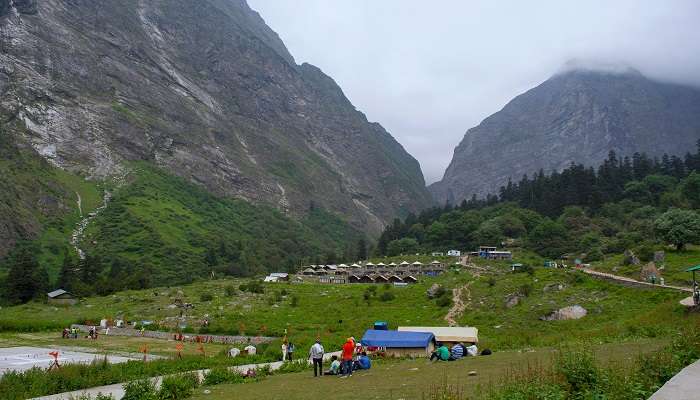
The accessibility in Ghagaria Village has gotten much better over the years, especially after the 2013 Uttarakhand Floods. Due to its recent popularity, accessibility to Ghagaria has become very easy. The Uttarakhand Floords in 2013 affected its accessibility briefly, but the village has seen major progress since then. Flights and trains can get you approximately 290 km from Ghagaria, where local transport can be hired to take you to the village. It is suggested that private cars be hired since the village is connected by good motorable roads from all the major towns and cities nearby. Adventure seekers can also undertake a 13 km hike from Govindghat among the lush green sceneries of the valley.
The weather in Ghagaria varies depending on the season. Monsoons bring about heavy rains, winters cover the place in snow and see temperatures around 10℃, while summers see temperatures up to 30℃. The best time to visit Ghagaria is between April and October, as the climate stays optimal for a comfortable visit. Due to the terrain, locals suggest children under 10 and senior citizens avoid the trek from Govindghar to Ghangaria. In addition, the higher altitude in Ghangaria could lead to the depletion of oxygen levels in the body. Therefore, visitors must acclimate before the trek and frequently check their blood saturation levels.
Further Read: Offbeat Places Near Rishikesh
Visiting the Ghangaria village should top the list for all nature lovers due to its pristine beauty and mesmerizing sights. As the gateway to the sacred Hemkund Sahib and the Breathtaking valley of flowers, this quaint village offers adventurous pilgrims a heaven of exploration and peace. Now that you know more about the village, take this opportunity to book your trip to Uttarakhand
and explore the natural paradise.
For our editorial codes of conduct and copyright disclaimer, please click here.
Cover Image Source: Shutterstock
Frequently Asked Questions About Ghangaria Village
What makes Ghangaria a unique starting point for the Valley of Flowers trek?
Ghangaria is the last human habitation on the way to the Valley of Flowers and Hemkund Sahib. Its unique location at an altitude of 3,050 meters makes it a natural base for trekkers. What sets Ghangaria apart is its seasonal character; it becomes a bustling hub from June to October when the trekking season is at its peak, but it turns into a ghost village covered in snow during the rest of the year. This seasonal shift gives Ghangaria a transient charm that is rare to find.
Does Ghagaria have any wildlife?
Yes, Ghangaria is a haven for unique wildlife. Trekkers often report sightings of the elusive snow leopard in the higher altitudes, although rare. More commonly, one might encounter the blue sheep, Himalayan monal, and the musk deer.
What’s the story behind Ghangaria’s name and its lesser-known local legends?
Ghangaria, also known as Govind Dham, derives its name from the abundance of ghagra in the area, a plant native to the area. Local legends speak of a shepherd who once lost his way and discovered the Valley of Flowers, leading to its eventual fame.
Does the seasonal change affect the local economy and lifestyle in Ghangaria?
Yes, the local economy and lifestyle of Ghagaria residents change significantly due to seasonal changes. The local economy of Ghangaria is heavily dependent on the trekking season. During the peak months, the village thrives with dhabas, lodges, and shops catering to trekkers. Locals engage in various businesses to cater to the influx of tourists, selling everything from woollen clothes to packaged snacks. However, in the off-season, most villagers move to lower altitudes, and the village falls into hibernation.
What are some tips for first-time visitors to Ghagaria?
- Electricity is available for only a few hours each day.
- Carry a reusable water bottle and refill it from natural streams along the way.
- Essentials like a good pair of trekking shoes, rain gear, and a basic medical kit are crucial.
- Carry back all non-biodegradable waste and be mindful of the fragile ecosystem.
People Also Read:
Global Village Nain Kheri Village Poland Vallges

Unveil the hidden treasures of the globe and turn every travel dream into reality. As a Content Writer, I am passionate enough to craft stories from ancient wonders to modern marvels. My words paint the picture-perfect itinerary for unforgettable experiences. Let my words be your trusted guide to immerse in the diverse culture and discover the beauty of the unknown.











